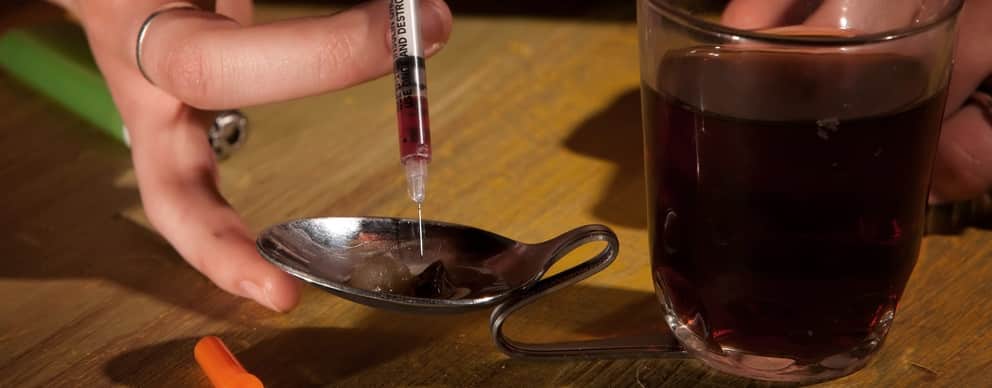Some heroin is sold as a brown powder, and there’s also something called “black heroin” or “black tar heroin”.
Heroin is a drug classified as an opioid. Opioids also include prescription pain medicines, and they’re powerful, very addictive drugs. Opioids bind to certain receptors located throughout the central nervous system, causing a euphoric high. This high triggers the brain’s reward system, which is how addiction develops. The brain becomes psychologically dependent on drugs, and drug-seeking behaviors are compulsive in a person struggling with addiction. There’s also physical dependence with opioids. If someone is dependent on heroin and tried to stop using, they would likely go through withdrawal.
When we think about heroin, we often think of a powder that’s white or off-white. That powder is then liquefied in order to be injected using a needle. There are variations of heroin, however. For example, some heroin is sold as a brown powder, and there’s also something called “black heroin” or “black tar heroin”. Injecting heroin carries its own set of risks in addition to the effects of the drug on the brain. For instance, injecting heroin can cause infections and the transmission of bloodborne diseases.

An Overview of Black Tar Heroin
Black tar heroin’s name comes from its appearance: black tar heroin is a dark brown or nearly black. This type of heroin is thick, gooey and similar to tar. It’s very distinctive from other types of heroin, which come in powder form, and is sold as a solid. It’s not difficult to determine whether a product is black tar heroin, even for people unfamiliar with heroin. While black tar heroin is still derived from morphine, but it has its own risks and dangers.
The psychological effects of black heroin are the same as other forms of the drug. When someone uses black tar heroin, some heroin is converted to morphine, but not all of it, and it creates a sense of euphoria. Following the euphoric high, the person using the drug experiences drowsiness or sedation. The drug can cause physical symptoms including flushed skin and dry mouth. Using heroin can cause people to feel as if their limbs are heavy, their cognition and thinking are impaired and they will likely nod off as the euphoria dissipates.
Black tar heroin can be injected or smoked. It may be snorted but this is a relatively uncommon way to consume black heroin. As with other forms of heroin, black tar can be dissolved in water so that it can then be injected. Paraphernalia associated with black tar heroin includes spoons, syringes, lighters, foil and cotton balls. If heroin is inhaled, it’s heated on a piece of foil and then the fumes are breathed in through something like a straw.
How Is Black Tar Heroin Different?
Black tar heroin is distinctive from other forms of heroin primarily because of its impurity. When heroin is produced traditionally, the result is a fine, white powder. The objective is to remove impurities. As the opioid epidemic has taken over in the U.S., there has been more of an effort on the part of drug dealers to cut corners and improve profitability. One result of this effort is black tar heroin.
Black tar heroin is produced when the process to purify the drug is shortened. Black tar heroin contains more impurities than a product that’s powdered and light-colored in most cases. The processing methods that create black tar heroin are very crude, leaving behind these visible impurities. Entire steps of the traditional heroin purification process are skipped in the creation of black tar.
Most of the black tar heroin that makes its way into the U.S. is produced in Latin America. It’s common in the southern and western regions of the U.S. When someone purchases this type of heroin, there is no way to determine the purity or quality of the product, and there’s very little consistency.
The Risks of Black Tar Heroin
There are more risks of using black heroin compared to traditional heroin, particularly for a person using intravenous drugs. When black tar is injected, there is a heightened risk for infections and conditions like venous sclerosis. Venous sclerosis is a condition where the veins become narrow and hardened. There’s also a greater risk of bacterial infections when black tar heroin is injected. For example, something called necrotizing fasciitis can occur. This is a flesh-eating disease that destroys tissue because of the bacteria from the black tar heroin. Injection of black heroin increases the risk of abscesses and something called gas gangrene, which also destroys body tissue.
These risks specific to black heroin are added to the long list of dangers that come from heroin use in general. For example, respiratory depression is one of the primary causes of death related to heroin use. With black tar heroin, the risk of overdose can be even higher because it’s so difficult to determine the potency or purity level of the drug. Collapsed veins and heart infections can occur in those taking drugs intravenously as well.
Black tar heroin is cheap and readily available in many parts of the country. It continues to flood into the U.S. to meet surging demands for opioids. Despite its increasing prevalence and popularity, black tar heroin’s crude manufacturing techniques leave people trying it open to infections and serious health issues in addition to the general risks of heroin.
If you or your loved one is struggling with a substance abuse problem, The Recovery Village offers opportunities for the treatment you’re looking for. We work with people with all types of addictions and provide them with tools they need to have a successful recovery. We invite you to learn more and take back your life.


The Recovery Village aims to improve the quality of life for people struggling with substance use or mental health disorder with fact-based content about the nature of behavioral health conditions, treatment options and their related outcomes. We publish material that is researched, cited, edited and reviewed by licensed medical professionals. The information we provide is not intended to be a substitute for professional medical advice, diagnosis or treatment. It should not be used in place of the advice of your physician or other qualified healthcare providers.